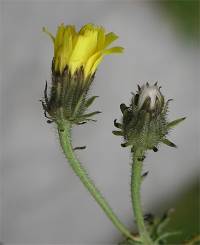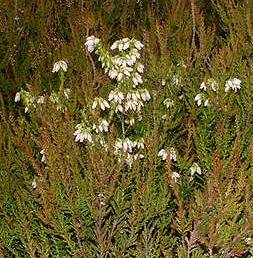Back to the Newsletter Contents and Home page
Botany Report 2005 (Reports for 2004)
by Gill Smith
 This
year saw some exciting developments, starting with a new record for this part of Yorkshire: limestone
bedstraw Galium sterneri, which Nan Sykes found in a quarry north of Helmsley in late summer.
It was still in bloom in October. This species resembles the common heath bedstraw we are familiar with
on acid soils but as its name suggests requires basic soils. Nan also found a striking yellow daisy
not previously recorded from our area: rough hawksbeard Crepis biennis growing on a verge at
Levisham in September (left, showing the characteristic “ruff”of this genus). On a more
local scale I found a new plant for my immediate vicinity near Gilling, storksbill (Erodium cicutarium),
in full flower in early November along with mayweed and field pansy (Viola arvensis).
This
year saw some exciting developments, starting with a new record for this part of Yorkshire: limestone
bedstraw Galium sterneri, which Nan Sykes found in a quarry north of Helmsley in late summer.
It was still in bloom in October. This species resembles the common heath bedstraw we are familiar with
on acid soils but as its name suggests requires basic soils. Nan also found a striking yellow daisy
not previously recorded from our area: rough hawksbeard Crepis biennis growing on a verge at
Levisham in September (left, showing the characteristic “ruff”of this genus). On a more
local scale I found a new plant for my immediate vicinity near Gilling, storksbill (Erodium cicutarium),
in full flower in early November along with mayweed and field pansy (Viola arvensis).
In general terms it seemed to be a relatively late spring, with the landscape not really “greening”
until 26th April. Later there was plenty of sun in late May which led to a wonderful display of hawthorn
blossom; for some reason many bushes faded through pale pink almost to red before the petals finally
fell, which I had not seen before.
It is also good to report that funding has been obtained to appoint a part-time manager for the cornfield
flower project. Chris Wilson has been appointed for 5 years, and his task will be to maintain and enlarge
the nursery and demonstration cornfield at the Ryedale Folk Museum, but mainly to get these rare arable
land plants increasingly out into the wider farming environment. Fortunately the timing is excellent
with the new single farm payment grant scheme starting this year – it offers various incentives
for conservation headlands and flower-rich land.
 The
undoubted botanical highlight as far as our field meetings was concerned was the trip to Fordon and
Wharram on the chalk in June, where we saw a tremendous variety of colourful plants in bloom, including
bee orchids, clustered bellflower, Venus’s looking glass and rockrose along with other less showy
species such as hop trefoil, hairy rock-cress and field mouse-ear. Up on the moors Tom Denney was lucky
enough to find this unusual plant of white heather on Rudland Rigg.
The
undoubted botanical highlight as far as our field meetings was concerned was the trip to Fordon and
Wharram on the chalk in June, where we saw a tremendous variety of colourful plants in bloom, including
bee orchids, clustered bellflower, Venus’s looking glass and rockrose along with other less showy
species such as hop trefoil, hairy rock-cress and field mouse-ear. Up on the moors Tom Denney was lucky
enough to find this unusual plant of white heather on Rudland Rigg.
Back to the Newsletter Contents and Home
page
Text copyright © Ryedale Natural History Society 2005.
 This
year saw some exciting developments, starting with a new record for this part of Yorkshire: limestone
bedstraw Galium sterneri, which Nan Sykes found in a quarry north of Helmsley in late summer.
It was still in bloom in October. This species resembles the common heath bedstraw we are familiar with
on acid soils but as its name suggests requires basic soils. Nan also found a striking yellow daisy
not previously recorded from our area: rough hawksbeard Crepis biennis growing on a verge at
Levisham in September (left, showing the characteristic “ruff”of this genus). On a more
local scale I found a new plant for my immediate vicinity near Gilling, storksbill (Erodium cicutarium),
in full flower in early November along with mayweed and field pansy (Viola arvensis).
This
year saw some exciting developments, starting with a new record for this part of Yorkshire: limestone
bedstraw Galium sterneri, which Nan Sykes found in a quarry north of Helmsley in late summer.
It was still in bloom in October. This species resembles the common heath bedstraw we are familiar with
on acid soils but as its name suggests requires basic soils. Nan also found a striking yellow daisy
not previously recorded from our area: rough hawksbeard Crepis biennis growing on a verge at
Levisham in September (left, showing the characteristic “ruff”of this genus). On a more
local scale I found a new plant for my immediate vicinity near Gilling, storksbill (Erodium cicutarium),
in full flower in early November along with mayweed and field pansy (Viola arvensis).  The
undoubted botanical highlight as far as our field meetings was concerned was the trip to Fordon and
Wharram on the chalk in June, where we saw a tremendous variety of colourful plants in bloom, including
bee orchids, clustered bellflower, Venus’s looking glass and rockrose along with other less showy
species such as hop trefoil, hairy rock-cress and field mouse-ear. Up on the moors Tom Denney was lucky
enough to find this unusual plant of white heather on Rudland Rigg.
The
undoubted botanical highlight as far as our field meetings was concerned was the trip to Fordon and
Wharram on the chalk in June, where we saw a tremendous variety of colourful plants in bloom, including
bee orchids, clustered bellflower, Venus’s looking glass and rockrose along with other less showy
species such as hop trefoil, hairy rock-cress and field mouse-ear. Up on the moors Tom Denney was lucky
enough to find this unusual plant of white heather on Rudland Rigg.